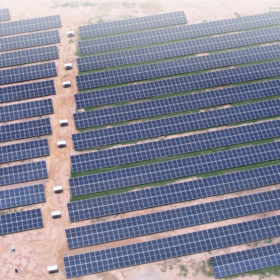A group of researchers from Northwest Normal University in China has fabricated a four-terminal (4T) tandem solar cell based on a top semi-transparent perovskite device and a bottom cell relying on copper-indium-gallium-selenide (CIGS).
“We used a stepwise dimethyl sulfoxide (DMSO) solvent-annealing method to improve the crystallinity of the perovskite film used in the perovskite top cell,” the research’s lead author, Yan Li, told pv magazine. “We fabricated films with a wide bandgap of 1.68 eV via two consecutive heating steps: annealing at 100 C and then 80 C.”
The scientists explained that the first step is intended to induce fast nucleation and efficient growth of film grains with high crystallinity, while the second step is aimed to release DMSO molecules preventing the sublimation of volatile organic halide species, thus avoiding lead(ii)iodide (PbI2) impurity phase growth.
Further electrochemical impedance spectroscopy (EIS) analysis showed that the stepwise solvent-annealing strategy was able to produce a perovskite film with larger grains, higher crystallinity, and purer phase than a control sample produced using the traditional solvent-annealing method.
The research group built the top perovskite cell with a substrate made of indium tin oxide (ITO) and glass, an electron transport layer (ETL) based on tin oxide (SnO2), the optimized perovskite absorber, a Spiro-OMeTAD hole transport layer (HTL), a molybdenum oxide (MoOx) layer, and a semi-transparent back contact made of indium zinc oxide (IZO).
This cell was able to achieve a power conversion efficiency of 21.26%, an open-circuit voltage of 1.210 V, a short-circuit current density of 21.43 mA/cm2, and a fill factor of 0f 82.0%. It was then combined with a bottom CIGS solar cell with an efficiency of 18.29%, with this efficiency value decreasing to 7.89 % after the bottom device is filtered by the semi-transparent perovskite cell.
“The efficiency achieved herein is among the highest values for 4-T PSC/CIGS tandem solar cells reported earlier,” the research team emphasized, noting that the result was mainly attributable to the high efficiency of the top perovskite cell and the high bifaciality factor of 92% achieved by its semi-transparent IZO electrode.
The cell was described in the paper “A stepwise solvent-annealing strategy for high-efficiency four-terminal Perovskite/Cu(InGa)Se2 tandem solar cells,” published in materials today Energy.
This content is protected by copyright and may not be reused. If you want to cooperate with us and would like to reuse some of our content, please contact: editors@pv-magazine.com.









By submitting this form you agree to pv magazine using your data for the purposes of publishing your comment.
Your personal data will only be disclosed or otherwise transmitted to third parties for the purposes of spam filtering or if this is necessary for technical maintenance of the website. Any other transfer to third parties will not take place unless this is justified on the basis of applicable data protection regulations or if pv magazine is legally obliged to do so.
You may revoke this consent at any time with effect for the future, in which case your personal data will be deleted immediately. Otherwise, your data will be deleted if pv magazine has processed your request or the purpose of data storage is fulfilled.
Further information on data privacy can be found in our Data Protection Policy.